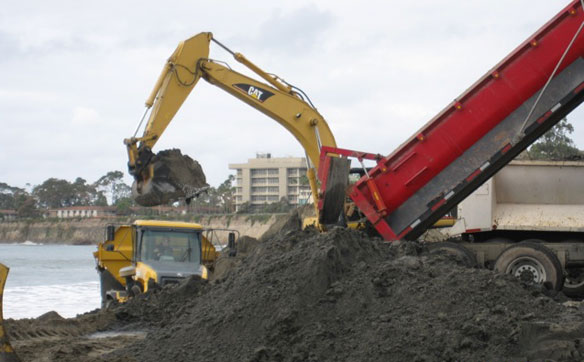
Beach re-nourishment, Goleta Beach, California, 2010. Photo source: ©SAF
Abstract: NS Shaler, Sea and Land, Features of coasts and oceans with special reference to the life of Man. London, p. 55-56, Smith, Elder and Co., 1895, 252 p.
Nathaniel Southgate Shaler, Powell’s Ally (1841–1906) a geographer, geologist, and dean of the Lawrence Scientific School at Harvard University, became, by the turn of the century, one of the most respected scholars in the country, in his specific field of scientific research.
In this retrieved article dated 1895, the author describes the transport of clasts by seaweed, makes footnote of sea wall and beach nourishment… most possibly a first.
“Sometimes these plants (seaweeds) attach themselves by their root-like bases-which are not in fact roots, for they serve only for support-to shells which lie prone or are fixed upon the bottom. More commonly they adhere to a pebble left on the sea-floor by the melting glacial sheet, or drifted out in the “pan-ice” which in winter forms along the sea margins. All these sea-weeds have floats which hold them upright in the water, and as they increase in size, they pull on their bases with constantly augmenting force. As the waves roll over them, they increase the tugging action, until finally, in some time of storm, the plant lifts lifts the stone from its bed and floats it in the water, buoyed up by the vesicles of air contained in its fronts. The plant and upturned stone are together borne in by the heave of the sea onto the shore. Coming into the breakers, the weed is quickly beaten to pieces, and the pebble enters the mill where so many of its fellows have met their fate. The close observer after a storm may find any number of these bowlders along a pebbly shore which still show traces of the sea-weeds which bore them to the coast…On a quarter of a mile of the Marblehead (MA) beach I have estimated that as much as ten tons of these seaweed-norne pebbles came ashore in a single storm. Many of the beaches which are so adequately provided with pebbles from the neighboring shores where the waves are attacking the firm land that they could not be maintained from that source alone, are sufficiently fed by the means of supply afforded by the action of marine plants. *”
* “On the parts of the shore where the land has been extensively occupied by summer residents, the owners have in many cases protected the coast from erosion by embankments and sea-walls, thus diminishing the amount of debris which was formerly contributed to the pocket beaches. In these artificial conditions the beaches often wear out, and the sea begins to assail the part of the coast which was once well protected. In such cases the only way in which the erosion can effectively be corrected is by carting each year to the beach a sufficient quantity of large bowlders to give employment to the waves and prevent their encroachment upon the shore. The larger these bowlders, the better; for if they are of small size they will be tossed about by slight storms and rapidly wear out, while masses weighing half a ton will be stirred only by the more tumultuous seas”.









